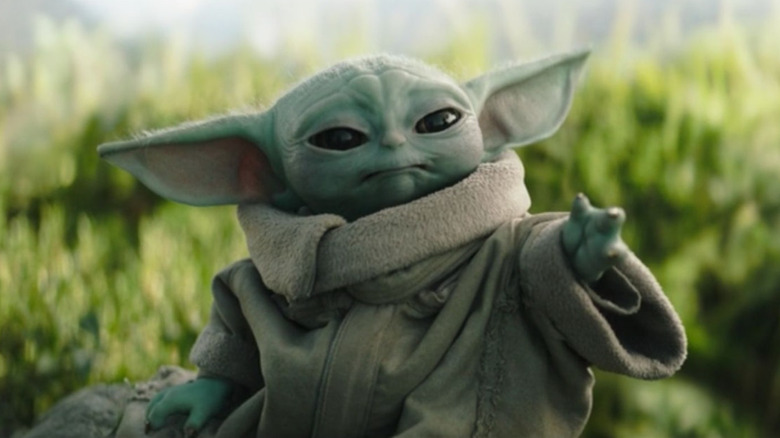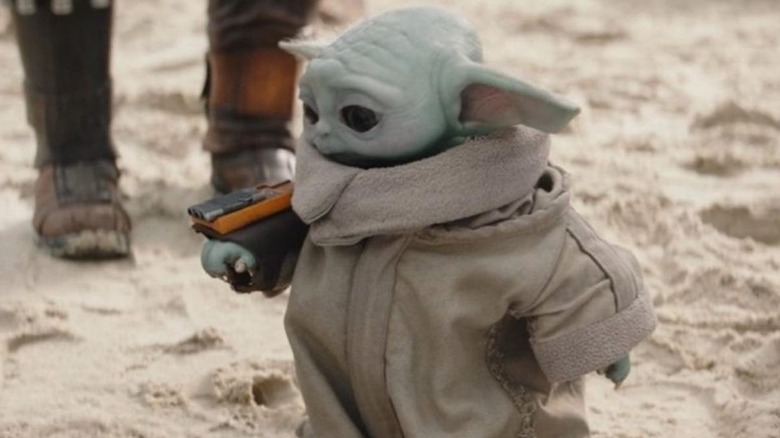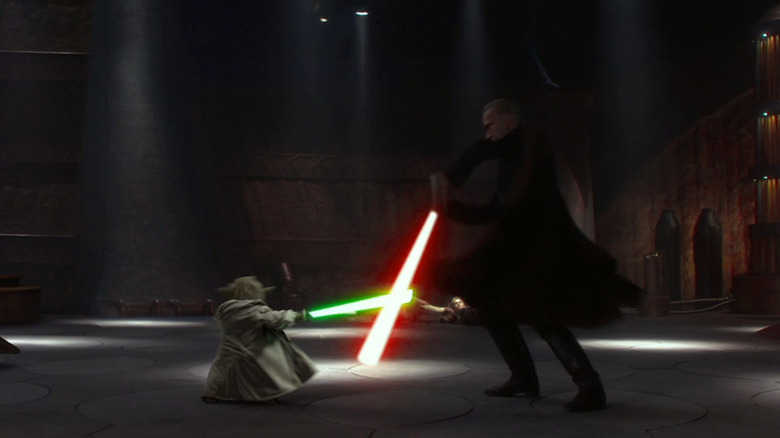Operating The Mandalorian's Baby Yoda Puppet Is More Complicated Than It Looks
Undeniably, there's a real artistry involved with digital visual effects (VFX) and advancements in technology have only added to the rich history of the craft (which goes back even further than most film fans may realize). The marriage of computer-generated imagery (CGI) with practical effects and puppetry has been a little rocky at times, but the world of "Star Wars" has continued to work hard to find the right middle ground between these techniques.
Indeed, the franchise has struck an especially effective balance in recent years with Din Djarin's little green son on "The Mandalorian." Whether you prefer to call him Grogu or Baby Yoda, Din's 50-year-old, miniature Force-using travel companion is easily the cutest and arguably the most compelling character in the galaxy right now. He's also proof that puppeteers and CGI artists can work together to achieve something truly magical.
For a character who immediately recalls Frank Oz's astounding work breathing life into Yoda in "The Empire Strikes Back," it's surprising to learn that there was some discussion early on about Grogu primarily being a computer-animated creation. "Initially, the puppet was going to be in a supporting role, and it was going to be a CG character," Legacy Effects co-founder and special effects supervisor, John Rosengrant told IndieWire. "We did a proof of concept three weeks before shooting, and even once we started shooting, I don't know that we were convinced that the puppet was going to do as much as it did," he added.
However, once creator Jon Favreau and his team were on set during the early days of shooting season 1, there was what Rosengrant dubbed an "aha moment" that showed what the puppet was capable of handling on its own. Industrial Light & Magic's VFX team came in when needed, but largely took their cues from the puppeteers working tirelessly to operate Grogu on the ground.
It takes a village to operate a Grogu
The versatility of the Grogu puppet was also due to the incredible level of detail that the artists over at Legacy Effects poured into him. Amusingly, the character's pointed ears proved to be one of the most difficult challenges when it came time to ensure Grogu was camera-ready. They had to show just the right amount of red veins, and it took four attempts to achieve the translucent look the VFX artists were going for.
For Grogu to be convincing, he also had to deliver a wide array of emotions ranging from curiosity to fear. That meant Legacy's rod-controlled puppet had to emote and act on command while avoiding the edict handed down from Jon Favreau to avoid too much cuteness and needless fan service. As a result, at any moment, there were three or four puppeteers (John Rosengrant included) trying every kind of combination with the mechanics in order to strike the right mixture of facial expressions and body movements. They all had to work in concert to sell the effect. Fortunately, judging by Pedro Pascal's reaction at the end of season 2 when the Grogu puppet brought tears to his eyes, the people at Legacy have absolutely done their job.
Speaking of which, the prototype Grogu puppet was given a few minor tweaks and improvements to make it a little easier for the puppeteers to control him in "The Mandalorian" season 2. "We went inside and tuned him up, made sure all his servos were fresh and good," said Rosengrant. "But it's the same character, you wouldn't know the difference." Apparently, even Grogu needs a tune up every once in a while.
Keeping the right balance as Grogu's Force powers grow
Currently, the mix of practical effects and CGI is staying pretty level. But as Grogu starts to grow up and continue to train and learn the ways of the Mandalorians, there's a concern that the intangible magic of the puppet will be replaced with computer-generated acrobatics. As Grogu's Force capabilities improve, he's already been seen leaping around a little too much in season 3 for my taste, personally. Yoda's duel with Count Dooku at the end of "Attack of the Clones" was thrilling to behold in its time, but is that really what fans want to see from Grogu?
Hopefully, ILM's VFX animator Hal Hickel — who works on Grogu and was also involved in animating the CG version of Yoda — will avoid over-relying on CGI going forward. "We learned how Frank Oz controlled the puppet from inside with his hands, why the face moved the way it did, how the ears had a rubbery vibration, and that helped here as well," Hickel explained to IndieWire. "We looked at the underlying mechanisms, and they're pretty simple on the Baby because he hasn't evolved yet. And it was a good lesson for our beginning animators in terms of less is more."
So, what happens when Grogu does evolve? "The Mandalorian" already has an abundance of action-heavy episodes and plenty of characters to dole out that action when necessary. Grogu wielding a blade and Force somersaulting all over the place could be a slippery road to go down. Can't he just keep moving rocks and eating frogs for a little while longer? Whatever happens, the show's VFX artists will try their hardest not to repeat the mistakes of the past to ensure that Grogu and "The Mandalorian" as whole stay on the right path.


